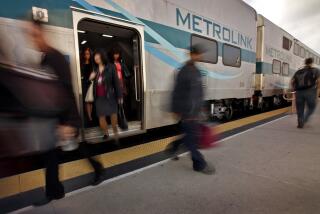Santa Clarita / Antelope Valley : Improvements Speed Metrolink : Transportation: Ridership still outstrips pre-quake levels. Agency hopes further upgrades will promote greater use.
- Share via
LANCASTER — When commuter trains first began rolling here a week after the Jan. 17 Northridge earthquake, Antelope Valley residents came aboard by the thousands. Although the 78-mile ride from Lancaster to Downtown Los Angeles took 2 hours and 25 minutes when the emergency service started, riders considered the Metrolink a comfortable way to avoid driving in a region where freeways had been crippled by the quake.
About 21,000 people a day rode the rails but Metrolink officials knew the trains were too slow to keep people from returning to their cars once the freeways were fixed.
In an effort to hold onto its newfound customers, Metrolink has spent tens of millions of dollars on track improvements, slicing 30 minutes off the commute time. And officials hope they can trim another 15 minutes in coming months.
“The track improvements are very important to the continued success of the line because very soon (the freeway) will be back to the speeds before the earthquake,” said Richard Stanger, Metrolink executive director. “We want to be in a situation where our travel times are competitive with the automobile.
“With these speed improvements we will definitely be competitive, besides being more convenient and less stressful.”
Ridership on the line from Lancaster to Los Angeles has averaged 3,900 per day in June, including 450 from the Antelope Valley, Stanger said. While the number of passengers has plummeted because of freeway improvements, the line is still carrying four times more than it had prior to the quake.
The travel time reductions should boost ridership, Stanger said, adding that he expects passenger loads out of the Antelope Valley alone to reach 1,000 by the end of the year.
A mailer recently sent to all Antelope and Santa Clarita valley residents that offers four free tickets has pushed up ridership by 500 to 700 daily, he said, noting the goal is that some of those passengers will get hooked on trains by trying them out.
Stanger said some people have been waiting for the length of travel to drop before trying out the trains.
So, with the Federal Emergency Management Agency footing the bill, Metrolink is spending $43 million on track improvements and another $7 million to upgrade a mile-long tunnel in the Newhall area, Stanger said.
One of the key improvements Metrolink has made is the installation of 10 miles of track between Lancaster and Palmdale, he said. The trains were traveling on freight track before the faster commuter tracks were put in.
Another factor in reducing travel time has been the straightening or banking of curves along the 33 miles of track between Palmdale and Santa Clarita. Stanger said even more track improvements are planned through Soledad Canyon.
Finally, speeds have increased from 10 to 25 m.p.h. in the Newhall tunnel as a result of track upgrades and reduced water leakage inside the tunnel, Stanger said. The plan is to get train speeds up to 40 m.p.h. through the tunnel, with additional work.
Although he is pleased with what has been done, Stanger said he had hoped the improvements would have come sooner.
“This is not as good as it will get,” he said. “This is a big step forward but we want to approach an hour and 40 minutes from Lancaster to Los Angeles. That’s 100 minutes to go 78 miles, which is pretty good considering stops.”
More to Read
Sign up for Essential California
The most important California stories and recommendations in your inbox every morning.
You may occasionally receive promotional content from the Los Angeles Times.










